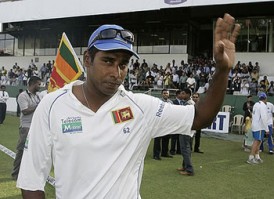Chaminda Vaas – His Test Career
Richard Dickinson |
Though his profile has raised as his career has gone on, the name Chaminda Vaas is unlikely to command any extraordinary attention in the cricket world outside Sri Lanka (within it he is rightly hailed as one of the finest cricketers yet produced by the country). This is due to a combination of circumstances. One is that Sri Lanka, despite the attractiveness and quality of their one-day international cricket and the fact that they have produced some of the most unique players in history, are still one of the least high-profile Test teams: in 28 years they have still not played a series of more than three matches, and in the UK they are one of the few countries whose home Tests not involving England are still not available to watch on television (a situation I suspect is similar elsewhere). Another is, of course, the fact that however good he has been, Vaas is certainly not one of the very best bowlers the game has ever seen. And another is the fact that, despite retaining the potential, all career, to be as devastating as any bowler ever when on-song, when he was so he tended to do his job quietly and only rarely crept out of the shadow of the ubiquitous Muttiah Muralitharan.
So Vaas might well come to be seen as one of the great under-rewarded players in cricket history – and not just in the sense that Sri Lanka Cricket has sometimes struggled to raise sufficient funds to pay its players their basic salaries. In truth there were times, plenty of them, when Vaas as a Test bowler was impossibly innocuous. And he was the polar-opposite of the vast majority of seam bowlers to have played the game in that he was better in dry, dusty conditions where he could utilise his skills of cut, swing and encouraging the batsmen to go after him than green, dank ones where he was required to seam the ball around and force batsmen to play at as much as possible.
Vaas will continue his ODI career, and it is that format which has brought him his most noted successes – generally he has been much more consistent in the shorter game than Tests. Even as his pace has slowed – never more than a modest fast-medium, often medium-fast, in recent years he has been nothing more than out-and-out medium – the effectiveness of his canny bag of tricks to make the ball talk, and of course, his superb accuracy, have ensured he has remained hard to score off outside the slog overs and a considerable threat with the new white ball. With a fair wind, Vaas should still be a force at the 2010/11 World Cup.
But his Test career – which spanned 15 years – is now over, and can be assessed on its own merits. It makes for puzzling reading. Consider this: Vaas played some part in 45 Test series against serious opposition (i.e., Bangladesh and the joke of a Zimbabwe side of 2003/04 not included); in 10 of these, he averaged 70+ (including here series’ in which he failed to take a wicket); in 9 further ones, he averaged 21 or less. In a further 5 he averaged between 41 and 53. His economy-rate did not tend to waver enormously: after 20 Tests it was 2.51-an-over; after 60, 2.6-an-over; after 100, 2.67-an-over. Vaas simply had a remarkable tendency to go from deadly to innocuous, and it was not a question of being neutered by lifeless subcontinental decks: three of his worst series’ came in England (2002 and 2006) and South Africa (2000/01), although admittedly in none did conditions conform to the archetype for either country.
Nor was it just a question of series-by-series changes. Consider, for example, Vaas’ record against Pakistan: in 18 Tests against them, 6 produced what might be described as excellent figures (5-99, 4-80, 4-75, 6-100, 5-113, 6-147); another 10 produced roundly poor figures (0-80, 1-75, 0-101, 3-156, 0-72, 0-82, 2-116, 0-66, 1-90); just a couple were standard-fare (5-139, 5-151). Or 12 Tests against Australia (6-150, 6-58, 4-54, 5-117, 7-82; offset by 2-103, 1-118, 0-31, 1-106, 0-154, 1-102).
Watching Vaas closely, it was impossible to explain these vicious extremes of form, not unlike fellow-countryman and opening batsman Marvan Atapattu, who could be impenetrable and unfathomable at a match’s, even an innings’, notice. No one opposition or set of batsmen ever clearly had the wood over him, though it’s true South Africa and India came close. Nor were his fortunes tied-in at all with Muralitharan’s, or any other bowler on his own team; he was as likely to turn it on or off regardless of whether Murali was ripping sides apart or being (as he occasionally, briefly, has been) muzzled. Perhaps no other bowler has had penetration, or lack of, so totally unrelated to their accuracy – which with Vaas was about as much of a given as any lesser of Curtley Ambrose or Shaun Pollock. Despite his short stature, the speed of the pitch mattered not a jot to him – if the edges were falling short, as happened not irregularly, he simply found ways to hit the stumps or the pads.
It is difficult to describe Vaas as “maddening”, a description which has been applied to many bowlers far less inconsistent than he. But when he is possibly your favourite bowler ever, it was sometimes difficult to not get a little frustrated with the extremes. A bowler who was capable of destroying most of the ideals typically associated with seam bowling – that the most effective perpetrators of all have to propel from considerable height andor at substantial pace – was easy to love, however. Vaas’ bag of tricks were a joy to watch when they were working. Precious few bowlers have sent down the off-cutter (leg-cutter to a right-handed batsman) with such effectiveness. And the violence, and lateness, with which he could swing the ball into the right-handed batsman (only ever in, whether it was conventional or reverse swing) to shatter stumps and thud into pads was as thrilling as bowling comes.
It was wonderful, too, to see him think hard, constantly, to outsmart batsmen. When England openers Michael Atherton and Marcus Trescothick used a method of communicating to each other which way Vaas was planning to swing the ball as he ran in (depending on which hand the non-striker held his bat in), it did not take long for him to sort that out, and take a leaf out of Wasim Akram’s book by holding the ball in both hands, denying anyone any insight. He was one of the best utilisers of the short-pitched delivery – under the vast majority of circumstances, he could go through whole spells without wasting his energy by bowling a single one, slipping in perhaps a couple per day as a surprise change-up. But very occasionally, if he spotted the potential of a blind spot (always possible with the left-arm-over angle), he could and did bombard batsmen with a shower of bouncers, which were usually difficult to hook despite the low trajectory and unremarkable pace.
Even if no real solution to the baffling conundrum of his inconsistency can ever be found – and it is unlikely any ever will – Vaas will always remain a Sri Lankan legend, and a fine Test match bowler. They are mantras he has worked incredibly hard to gain, and deserves as much as anyone ever has. Warnakulasuriya Patabendige Ushantha Joseph Chaminda Vaas should be saluted by all who enjoy cricket, and be wished well for the remainder of his ODI career.





nice article!
Comment by Lostman | 12:00am BST 19 August 2009
Congratulations to Chaminda Vaas on a great Test career, he is definitely one of the most under-rewarded cricketers.
Comment by Mupariwa_Magic | 12:00am BST 20 August 2009